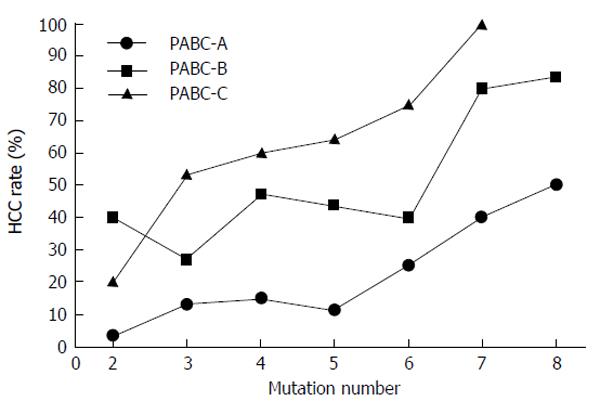Copyright
©The Author(s) 2015.
World J Hepatol. Jan 27, 2015; 7(1): 113-120
Published online Jan 27, 2015. doi: 10.4254/wjh.v7.i1.113
Published online Jan 27, 2015. doi: 10.4254/wjh.v7.i1.113
Figure 1 The number of mutations positively correlates with the rate of hepatocellular carcinoma: Pearson’s correlation = 0.
9614 (95%CI: 0.8225-0.9921; P = 0.0000). HCC: Hepatocellular carcinoma.
Figure 2 The number of mutations positively correlates with advanced liver disease, and advanced liver disease correlates with hepatocellular carcinoma.
However, the number of mutations is correlated with hepatocellular carcinoma independent of advanced liver disease. We arbitrarily divided the clinical stages based on a combination of four laboratory parameters, including platelet counts, albumin levels, total bilirubin, and prothrombin time. The categories were defined according to PABC clinical staging: PABC-A exhibits normal values for the four parameters; PABC-B exhibits abnormal values for one or two biochemical parameter(s) in addition to abnormal platelet counts; and PABC-C exhibits abnormal values for all four laboratory parameters. Pearson’s correlation coefficient was 0.933 for PABC-A (95%CI: 0.6061-0.9903; P = 0.0021), 0.822 for PABC-B (95%CI: 0.1822-0.9729; P = 0.0231), and 0.938 for PABC-C (95%CI: 0.5285-0.9933; P = 0.0057). PABC: Platelet-albumin-bilirubin-coagulation ability (prothrombin time).
- Citation: Park YM. Clinical utility of complex mutations in the core promoter and proximal precore regions of the hepatitis B virus genome. World J Hepatol 2015; 7(1): 113-120
- URL: https://www.wjgnet.com/1948-5182/full/v7/i1/113.htm
- DOI: https://dx.doi.org/10.4254/wjh.v7.i1.113














